Imagine that you are about to leave for work and press the garage door opener. However, you notice that something is wrong with your garage door that is stopping it from moving. Sad to say, not everyone knows that is a clear sign of an unbalanced garage door. While it is a fairly common case, people tend to overlook this issue with their doors.
In this blog, we will talk about what unbalanced garage doors are, why they happen, and how to fix them. Whether you like to DIY or hire a professional, we will help you keep your garage door safe and working smoothly. Let us get started and find out how to make your garage door balanced again.
How to Tell if You Have an Unbalanced Garage Door
Recognizing an unbalanced garage door is important for keeping it safe and working properly. To identify an off-balance garage door, look for these warning signs:
- Uneven movement: An unbalanced garage door is most obvious when it lifts unevenly. Something is wrong if one side moves faster than the other. Another sign of an imbalance is the door looks crooked when it opens or closes.
- Strange noises: Often, strange sounds like creaking, groaning, or pulling are signs of an unbalanced garage door. Some parts of the mechanism are probably under more stress than they should be, making it hard for them to operate smoothly.
- Slow or halting movement: If your garage door moves slower than usual, or worse, stops midway, this could be because of uneven weight distribution. An unbalanced door can cause these symptoms because the motor has to work harder to move it.
- Difficulty in manual operation: Try opening the door by hand without using the automatic opener. The door should be able to open and close easily and stay open about three to four feet off the ground. It is not balanced if it falls quickly or is hard to lift.
- Excessive wear on springs and cables: Check the garage door springs and cables. It means that the weight is not even, which is putting an extra strain on one side.

Common Cause of an Unbalanced Garage Door
An unbalanced garage door can be very unsafe and make your garage door system less effective. For safety and efficiency reasons, it is crucial to know what causes this problem. Here are some of the common culprits:
Wear and Tear of Springs
The garage door springs wearing out is one of the main reasons garage doors become unbalanced. Garage doors typically use either torsion or extension springs to balance and lift the door. This ongoing tension can make these springs weaken or break in the long run. If one of the springs on the door is weak, it can lift unevenly, which can make the whole thing unbalanced. If your door closes too fast, opens unevenly, or will not stay open, it might have a problem with its springs.
Issues with the Garage Door Tracks or Rollers
The garage door tracks and rollers help the garage door move and stay in place as it opens and closes. If these components are out of alignment, damaged, or obstructed, it can cause the door to become unbalanced. It also results in uneven movement and strain on one side of the door.
Imbalance Due to Improper Installation or Old Age
An uneven garage door is sometimes the result of a poor installation. An improperly balanced garage door may wobble sooner or later. Also, as a garage door gets older, different parts can wear out or move, which can throw the balance off. Regularly checking the garage door parts can help find the wear and tear that comes with age.
Environmental Factors
Changes in the weather, such as temperature and humidity, can also throw off the balance of a garage door. For example, wood garage doors might expand or contract due to humidity changes, affecting how they move on the tracks. On the other hand, metal components like springs and tracks can contract in cold weather or expand in hot weather, affecting the door’s balance.
How to Fix a Minor Garage Door Imbalance on Your Own
A slight garage door imbalance is usually easy, and you can handle it yourself as long as you are cautious. Look at this guide for how to do it:
Adjust the Tension in the Springs
- Safety first: Before beginning, ensure your safety. Make sure the garage door is closed, and put on safety glasses and gloves.
- Identify the springs: Find the torsion springs that are on top of the garage door. The steps will be a little different if your door has extension springs along the tracks.
- Secure the door: To prevent the door from opening while you work, clamp locking pliers onto the track just below the bottom roller.
- Adjust the torsion springs: If the door is hard to open or closes too quickly, the springs may be too tight. If not, the springs may be too loose if the door opens too quickly or is hard to close. To adjust, insert a winding bar into the winding cone of the torsion spring. Then, hold the bar in place and loosen the set screws. Carefully adjust the tension by turning the winding bar. A quarter turn at a time is a good rule of thumb.
- Test the balance: Take the clamps off and lift the door by hand. If the balance is right, it should stay open about three to four feet above the ground.
Check and Realign the Tracks
- Inspect the tracks: Look for bends, dents, or gaps between the rollers and the track. The tracks should be perfectly vertical along the vertical sections.
- Loosen the screws: If it needs adjustments, loosen the screws that hold the tracks to the frame.
- Adjust the track: Gently tap the track back into the correct position using a rubber mallet. Use a level to ensure it is perfectly vertical.
- Retighten and test: Once aligned, retighten the screws and test the door’s movement.

Lubricate Moving Parts
- Choose the right lubricant: Use a silicone-based lubricant or garage door spray. Avoid heavy oils or WD-40.
- Lubricate springs, rollers, and hinges: Apply the lubricant to the torsion springs, rollers, and hinges. It reduces friction and noise and extends the life of these parts.
- Don’t over-lubricate: Apply just enough to cover the parts without dripping.
Know When to Replace Worn-Out Parts
- Inspect regularly: Look for signs of wear, like frayed cables, bent tracks, or worn rollers.
- Replace springs, rollers, and cables: Garage door springs have a limited lifespan, often around 10,000 cycles. If they show signs of wear or break, it is time to replace them. This job can be dangerous, and it might be best to seek help from a licensed garage door expert.
When to Get Help from a Garage Door Professional
It is time to call a garage door specialist when there are major imbalances, broken springs, or damage to the structure. If you try to fix these things yourself, you could end up putting yourself in danger. It can also void your warranty and end up needing more expensive repairs in the future. Thus, it is beneficial to hire a qualified, insured, and well-known garage door repair service. You can do this by looking at their credentials, customer reviews, and prices. The skills of a pro not only ensure your safety but also the longevity and proper functioning of your garage door.
Garage Door Maintenance Service Near Me
Looking for the best garage door maintenance service in Omaha, NE? No more searching. At Titan Garage Doors NE, we guarantee that our trustworthy and affordable services will make your garage door durable and functional. We provide garage door services for homeowners and businesses, including adjusting the balance of garage doors and garage door spring replacement. Our skilled technicians will keep your garage door in perfect balance, giving you the peace of mind you deserve. Do not wait until it is too late! Call us today for a free quote.
